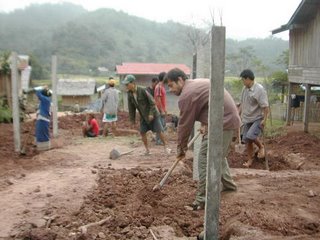A Learning Experience Part 5
Resettlement
In my opinion one of the key stumbling blocks for a successful volunteer placement is twofold: 1. a lack of knowledge and familiarity with the socio-political situations of the people for whom we are supposed to be assisting; and 2. the relatively short length of time we will be living in the community and the high degree of turnover for volunteers.
For the first point, I can say without a doubt, I was, and still am to a large degree, ignorant about all things Lao. Sure, I did as much research as I could before coming here. I was aware of some of the larger issues like the limited access to potable water, or the degree of deforestation and illegal logging that was apparently taking place, among other things, but these are merely the surface, a reflection of those issues that are allowed to filter up to the general media and the public outside of Lao.
Upon my arrival and the start of my placement, I quickly learned just how little I knew and how wrong the little I thought I knew turned out to be. Unfortunately, CUSO was going through a fair amount of instability and turmoil when I first arrived (although they still did a great job of making us feel welcome and comfortable and that we had everything we needed), but nevertheless it’s not like they were able to sit us down and give us a full briefing on the issues we might have to deal with. As a result, I have mostly stumbled along at my own pace discovering certain realities and issues, mostly by mistake. The most perfect, and quite possibly one of the most important issues of this nature is resettlement.
Since the 1970’s the national government of Lao has had a policy of moving isolated upland villages down into focal areas closer to roads and larger centres. The government has given five official reasons for the policy. These include:
1. Provision of services and infrastructure
The government has insisted that by moving villages down into the valley bottoms and into larger villages, these communities will be easier to provide essential infrastructure such as roads, hospitals, schools, etc. Also, by being closer to roads villages will have access to greater markets and thus will become part of the market economy. The rational being something like “if we can’t bring development to the people, we might as well bring the people to development.”
2. Eradication of Opium production
Under pressure from the international community, particularly the United States, the Lao government had, until quite recently, the stated policy of eradicating opium production in Lao by 2005. Last year, they announced the successful completion of this goal, claiming Lao to be completely opium free. (I’m sure the drug dealers on every street corner in almost any sizable town in Lao had a good chuckle over that one!). As a part of resettlement the rational was that by moving seemingly impoverished communities out of the highlands and providing them land and new economic opportunities, the people would naturally move away from growing and selling opium.
3. Eradication/stabilization of shifting cultivation
Shifting cultivation, most commonly referred to as “Slash & Burn” denoting the practise of people in upland areas to clear land by falling and cutting bush and then burning it, is a very common feature of the landscape in Lao, and more often than not an essential livelihood strategy for nearly 80% of the population; a group that is typically the poorest and most marginalized throughout the country. Associated with poverty and environmental degradation, and with the support and pressure from international funding and development organization such as the United Nations Development Program and the World Bank, the government has a policy with the goal of eradicating the practise of shifting cultivation and encouraging and fostering the development of more low land sedentary agriculture. With respect to resettlement, the rational was that by moving shifting cultivators out of the uplands and supplying them land for agriculture and alternative forms of income generation, people would naturally move away from slash and burn.
4. Security
Over the last several decades since the Indochinese/American war, Lao has had a series of ongoing internal and external conflicts. Internally, there are still factions operating in Lao to this day that are still loyal to the monarchy or have other grievances. In the not so distant past there have been shootings, bombings as well as other insurgent activities. As a result the government has endeavoured to move groups that are deemed a security risk and put them in areas where they can be watched or where they perhaps will lose their interest or motivation for certain “inappropriate” behaviours
5. Nation Building
By moving isolated communities out of the highlands and down into larger communities, they will naturally integrate into the larger, more civilized, Lao Leum culture and become more attached to the Lao People’s Democratic Republic (Does this sound familiar to anyone?).
*Although there are a number of reports and articles that discuss and describe the offical policy reasons for resettlement, the particular format I've just employed was taken from a research report recently published by a Canadian Research Institute. Should anyone want greater detail as to citations please email me and I would be more than happy to pass on all references and copies of this paper.
So there you have it, this is the official policy statements—as best I could find out about them anyways. Next blog I will discuss some of the issues and consequences I have learned of over the last 16 months. Stay tuned.


0 Comments:
Post a Comment
<< Home